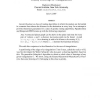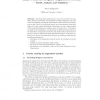ADHOC
2005
14 years 6 months ago
2005
Geographic routing protocols base their forwarding decisions on the location of the current device, its neighbors, and the packets destination. Early proposed heuristic greedy rou...
SODA
2008
ACM
14 years 7 months ago
2008
ACM
Greedy Routing is a class of routing algorithms in which the packets are forwarded in a manner that reduces the distance to the destination at every step. In an attempt to provide...
SIROCCO
2008
14 years 7 months ago
2008
The augmented graph model, as introduced by Kleinberg (STOC 2000), is an appealing model for analyzing navigability in social networks. Informally, this model is defined by a pair...
ESA
2006
Springer
14 years 9 months ago
2006
Springer
Abstract. Social networks are navigable small worlds, in which two arbitrary people are likely connected by a short path of intermediate friends that can be found by a "decent...
COMPGEOM
2007
ACM
14 years 10 months ago
2007
ACM
Sensor networks are emerging as a paradigm for future computing, but pose a number of challenges in the fields of networking and distributed computation. One challenge is to devis...
STOC
2004
ACM
14 years 11 months ago
2004
ACM
Several peer-to-peer networks are based upon randomized graph topologies that permit efficient greedy routing, e.g., randomized hypercubes, randomized Chord, skip-graphs and const...
ESA
2005
Springer
14 years 11 months ago
2005
Springer
Milgram’s experiment (1967) demonstrated that there are short chains of acquaintances between individuals, and that these chains can be discovered in a greedy manner. Kleinberg ...
WDAG
2005
Springer
14 years 11 months ago
2005
Springer
We study greedy routing over n nodes placed in a ring, with the distance between two nodes defined to be the clockwise or the absolute distance between them along the ring. Such ...
MOBICOM
2006
ACM
15 years 3 hour ago
2006
ACM
It was recently reported that all known face and combined greedy-face routing variants cannot guarantee message delivery in arbitrary undirected planar graphs. The purpose of this...
ESA
2007
Springer
15 years 6 days ago
2007
Springer
Abstract. The small world phenomenon, a.k.a. the six degree of separation between individuals, was identified by Stanley Milgram at the end of the 60s. Milgram experiment demonstr...


